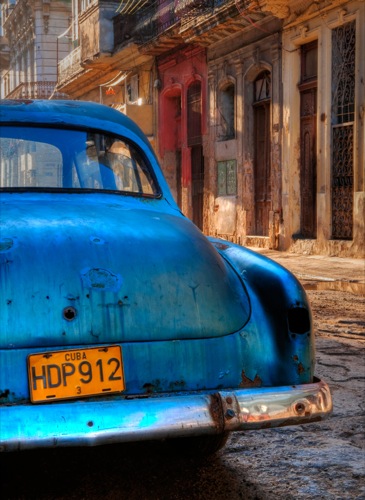
Courtesy AWL Images
This is no ordinary performance of “Romeo and Juliet.” The fast-paced script, spoken with a Caribbean Spanish inflection, is a far cry from Shakespeare’s original iambic pentameter. And there is a surprising amount of dancing for a classical tragedy, but then, nobody dies in this version.
Oh, and the actors are tiny.
I’m at the Santa Maria Art School and Cultural Center in the small town of Santa Maria, Cuba, where a children’s theater group has convened to perform “A Cuban Romeo and Juliet” for a group of American visitors. The performance is colorful, riveting and altogether adorable. My travel companions and I are immediately smitten.
This group of Americans has come to Cuba — a destination forbidden for 50 years — with Chamber Explorations, a travel brand operated by Premier World Discovery. Chamber Explorations is among a handful of American tour companies that have received a special license from the U.S. government to take American visitors to Cuba under the People-to-People travel provision instituted by the Obama administration. According to the provision’s regulations, American groups must have a full-time itinerary of personal interactions with the Cuban people approved in advance by the U.S. government.
Chamber Explorations and Premier World Discovery invited me to join the tour as a guest to encounter Cuba and its people for myself. That’s why I’m here with several dozen travelers, experiencing “Romeo and Juliet” in a whole new way.
Over the course of this nine-day tour, I’ll discover the enduring beauty and optimism of the Cuban people and come to cherish their customs, from traditional farming and religious practices to a culture of world-class art and music.
A Passionate Performance
The Santa Maria Art School and Cultural Center is set inside a beautiful classical building in the town square. The theatrical presentation takes place on the second floor, where the children earnestly sing, dance and act for the audience in this intimate setting.
There must be a couple dozen children in this dance and theater troupe, all between the ages of 6 and 14. Accompanied by their parents, technicians, musicians and directors, their ranks swell to rival the size of the American audience. The director introduces the play as a “Cuban ‘Romeo and Juliet’” and advises us that it would be different than the story we know. It is different indeed.
The children wear traditional Cuban costumes and perform the 10-minute play in Spanish. It doesn’t take a translator to understand what is happening: Although Romeo and Juliet are in love, their fathers are feuding with each other, thus inhibiting the budding romance. When the respective mothers find out about this, they quickly set their husbands straight with a bit of slapstick violence. A wedding ensues, and there is a lot of dancing.
Before we know it, the choreographed dancing evolves into an interactive fiesta. Although I’m not a big dancer, it’s difficult to say no when a doe-eyed 5-year-old girl takes you by the hand and asks you to join her. In minutes, the entire group of Americans is dancing with the children, along with their parents and instructors.
After the dancing ends, our group members are eager to talk to their new friends, take pictures and hug before saying goodbye. In less than an hour, this group of children chips a brick out of the cultural and political wall that divides our two nations.
A Miracle of Music
Another day we visit Cienfuegos, a beautiful small city known as the “Pearl of the South.” Established by the French in 1819, this city reflects a refined colonial aesthetic in its layout and architecture, a welcome change from the Soviet-style block buildings found in many other parts of the country.
We get off the motorcoach at the foot of a long pedestrian avenue and slowly make our way uphill to the town square. As we go, our guide, Israel, takes us into a number of stores to illustrate the contrasts and confusion of Cuba’s economy, which uses two different currencies, one for locals and one for visitors.
At the top of the hill, we enter the Thomas Terry Theatre, an 1889 building. We’re going to hear a performance by the local chamber orchestra. As we pile into the small fluorescent-lit room, nobody has high expectations for this experience.
The first note changes everything. Within seconds, we are awash in a sea of beautiful sounds with a richness of texture and a depth of tone that belie the small size of the ensemble and the bare surroundings of the performance hall. The 10 musicians are no amateurs, but experts who could hold their own amongst the world’s best.
For about half an hour, our group sits in rapt attention as the Orquestra de Cámera Concierto Sur (Southern Chamber Concert Orchestra) plays classical masterpieces, American show tunes and Cuban “danzónes.” Each piece receives applause more vigorous than the last. With the opening chords of the beautiful “Somewhere Over the Rainbow,” I see tears welling in several people’s eyes.
After the concert, we have a short question-and-answer session with the musicians. They tell us about their musical training and the challenges of performing in Cuba. The humidity wreaks havoc on delicate wooden instruments, and it’s very difficult to get new violin strings. Most are imported from Europe at great expense.
Our group members eagerly buy all the CDs the group has for sale, and some music fans from Tempe, Arizona, begin talks with the conductor to see about arranging for the orchestra to perform in the United States. I’ll learn later that, in a remarkable feat of persistence, the Americans make it happen, bringing this Cuban orchestra to the States for a groundbreaking performance in Tempe.
This people-to-people experience will turn out to be more profound than anyone had expected.









